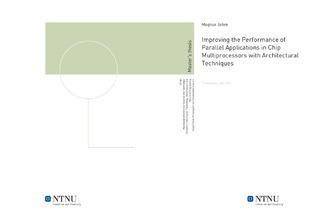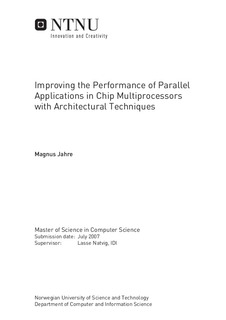| dc.description.abstract | Chip Multiprocessors (CMPs) or multi-core architectures are a new class of processor architectures. Here, multiple processing cores are placed on the same physical chip. To reach the performance potential of these architectures with a single application, it must be multi-threaded. In these applications, the processing cores cooperate to solve a single task, and this requires a large amount of inter-processor communication in many cases. Consequently, CMPs need to support this communication in an efficient manner. To investigate inter-processor communication in CMPs, a good understanding of the state-of-the-art of CMP design options, interconnect network design and cache coherence protocol solutions is required. Furthermore, a good computer architecture simulator is needed to evaluate both new and conventional architectural solutions. The M5 simulator is used for this purpose and has been extended with a generic split transaction bus, a crossbar based on the IBM Power 5 crossbar, a butterfly network and an ideal interconnect. The unrealistic ideal interconnect provides an upper bound on the performance improvement available from enhancing the interconnect. In addition, a directory-based coherence protocol proposed by Stenström has been implemented. The performance of 2-, 4- and 8-core CMPs with crossbar and bus interconnects, private L1 caches and shared L2 caches is investigated. The bus and the crossbar are the conventional ways of implementing the L1 to L2 cache interconnect. These configurations have been evaluated with multiprogrammed workloads from the SPEC2000 benchmark suite and parallel, scientific benchmarks from the SPLASH-2 benchmark suite. With multiprogrammed workloads, the crossbar interconnect configurations perform nearly as well as a configuration with an ideal interconnect. However, the performance of the crossbar CMPs is similar to the performance of the bus CMPs when there is intensive L1 to L1 cache communication. The reason is limited L1 to L1 bandwidth. The bus CMPs experience a severe performance degradation with some benchmarks for all processor counts and workload classes. A butterfly interconnect is proposed to alleviate the L1 to L1 communication bottleneck. The butterfly CMP performs on average 3.9 times better than the bus CMP and 3.8 times better than the crossbar CMP when there are 8 processor cores. These numbers are based on the performance of the WaterNSquared, Raytrace, Radix and LUNoncontig benchmarks. The reason is that the other SPLASH-2 benchmarks had issues with the M5 thread implementation for these configurations. For the multiprogrammed workloads, the butterfly CMPs are a bit slower than the crossbar CMPs. | nb_NO |

